

























Aeronca C-2
Single-engine Single-seat Ultralight Monoplane

Archive Photos 1
1930 Aeronca C-2, NC647W, s/n 27, at the Yanks Air Museum, Chino, California (Photos by John Shupek)

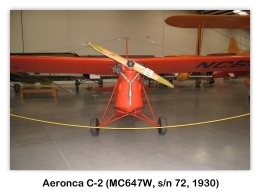

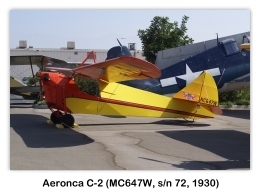

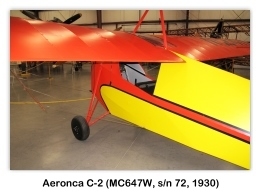
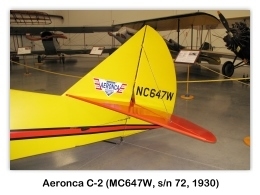
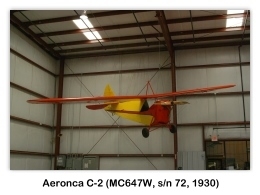
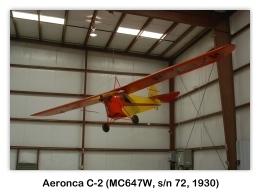
1932 Aeronca C-2 Scout (N11417) at the Virginia Aviation Museum, Sandston, VA (Photos by John Shupek)

Overview 2
- Aeronca C-2
- Role: Ultralight monoplane
- National origin: United States
- Manufacturer: Aeronca Aircraft
- Designer: Jean A. Roche
- First flight: 1929
- Number built: 164
- Unit cost: $1495 in 1929
- Developed from: 1925 Roche Monoplane
- Variants: C-1 Cadet, Aeronca C-3 Master
The Aeronca C-2 is an American ultralight monoplane designed by Jean A. Roche and built by Aeronca Aircraft.
Roche Monoplane 2
Jean A. Roche was a U.S. Army engineer at McCook Field airfield in Dayton, Ohio. Roche developed an aircraft with automatic stability and was granted U. S. Patent No. 1,085,461. Roche published his engineering ideas for the aircraft in Aerial Age Weekly and Slipstream Monthly magazines. The prototype was started in Ohio in 1923 with the assistance of fellow engineer Quienten Doshse. The aircraft used a triangular cross section welded steel tube fuselage, with wood wings, was fabric covered, and used wire bracing throughout. A Henderson engine was installed, but did not perform well. Next a custom 29 hp two cylinder Morehouse engine was developed for the aircraft. On September 1, 1925 the aircraft was successfully test flown. Many pilots including Jimmy Doolittle tried out the aircraft. Wright Aeronautical hired Morehouse and rights to his Wright-Morehouse WM-80 engine. Left without an engine, They turned to Robert E. Galloway of the Aeronautical Corporation of America to use the Aeronca E-107 engine. The rights to the aircraft were sold to Aeronca in 1928 as the basis for the C-2 Design.
Aeronca C-2 2
The Aeronca C-2, powered by a tiny two-cylinder engine, debuted in 1929. It was flying at its most basic, the pilot sat on a bare plywood board. The C-2 featured an unusual, almost frivolous design with an open-pod fuselage that inspired its nickname, The Flying Bathtub, The general design of the C-2 could have been inspired by Jean Roche’s initial flight experiences with an American-built copy of the Santos-Dumont Demoiselle, which had a similar triangular "basic" fuselage cross-section, and wire spoked main landing gear wheels right up against the fuselage sides.
Equipped with only five instruments, a stick, and rudder pedals … brakes and a heater cost extra … the C-2 was priced at a low $1,495, bringing the cost of flying down to a level that a private citizen could aspire to and perhaps reach. Aeronca sold 164 of the economical C-2s at the height of the Great Depression in 1930-1931, helping to spark the growth of private aviation in the United States.
The Aeronca C-2 also holds the distinction of being the first aircraft to be refueled from a moving automobile. A can of gasoline was handed up from a speeding Austin automobile to a C-2 pilot … who hooked it with a wooden cane … during a 1930 air show in California. A seaplane version of the C-2 was also offered, designated the PC-2 and PC-3 (P for pontoon) with floats replacing the wheeled landing gear.
A single Aeronca C-2 was converted to a glider by H.J. Parham in England after an in-flight engine failure and forced landing. The nose was faired in after the removal of the engine. It first flew as a glider 15 May 1937 and went to the Dorset Glider Club but was destroyed in the club hangar during a storm in November 1938.
Variants 2
- Aeronca C-2 — Single-seat light sporting aircraft, powered by a 26-hp (19-kW) Aeronca E-107A piston engine.
- Aeronca C-2 Deluxe — Improved version, with a wider fuselage and a number of design improvements.
- Aeronca C-2N Scout — De luxe sporting aircraft, powered by a 36-hp (27-kW) Aeronca E-112 or E-133A piston engine. Four built.
- Aeronca PC-2 — Seaplane version of the C-2.
- Aeronca PC-2 Deluxe — Seaplane version of the C-2 Deluxe.
Specifications and Performance Data (Aeronca C-2) 3
Type
- Single-engine single-seat light monoplane.
Wings
- High-wing wire-braced monoplane.
- Wings, of Clark "Y" section, in two sections, attached at the center-line to the single top longeron of the fuselage.
- They are wire-braced for both to a cabane and below to the bottom fuselage longerons.
- Structure consists of two solid spruce spars, with reinforcing blocks at the points of attachment of the bracing wires and at the roots, solid spruce or bass compression ribs and ordinary ribs, double wire drag-bracing, the whole being covered with fabric.
- The ailerons are entirely of duralumin construction and are interchangeable.
Fuselage
- Welded steel-tube structure, with five nearly-parallel longerons forward and three from the back of seat aft to the tail-post.
- The section of the fuselage forward is square and aft triangular.
- The single top longeron acts as the anchorage for the wings forward and forms the apex of the triangular-section fuselage aft.
- The two mid-longerons which form the top of the forward section in the region of the cockpit terminate aft of the cockpit.
Tail Unit
- Normal monoplane type.
- Welded steel-tube framework covered with fabric.
- The fin is built integral with the fuselage.
- The right and left elevators and tail-planes are interchangeable.
- The tail-plane is adjustable on the ground.
Undercarriage
- Divided type.
- Consists of two independent streamlined steel-tube tripods bolted to the fuselage.
- To these tripods are attached short stub-axles, on which are mounted Goodyear Airwheels.
- Twin floats may be attached to the fuselage by eight struts and two wire fittings.
- The landing gear attaching points are used for four of the struts and the two wire fittings.
- The floats are metal-covered, are of the round-topped and curved Vee-bottom type, with five watertight compartments.
Power Plant
- One 30 hp Aeronca E-107-A or 36 hp Aeronca E-113 two-cylinder horizontally-opposed air-cooled engine.
- Engine suspended on three points on a welded steel-tube mounting built integral with the fuselage.
- Main fuel tank holding 8 U.S. gallons standard to all machines.
Accommodation
- Open cockpit under the wings, seating one.
- Transparent panels in the wing-roots give upward vision.
- Large windscreen in front of cockpit.
- Luggage compartment behind seat.
- Control column and rudder bar in single-seat model, but two-seat type has rudder pedals.
- Cables and pulleys are used throughout the control system.
Dimensions
- Span: 36 ft (10.9 m)
- Length: 20 ft (6.1 m)
- Height: 7 ft 6 in (2.28 m)
- Wing Area: 142.2 ft.2 (13.2 m²)
Weights and Loadings
- Weight empty: 426 pounds (193.4 kg)
- Petrol and oil: 54 pounds (24.4 kg)
- Pilot: 170 pounds (77 kg)
- Baggage: 50 pounds (22.7 kg)
- Weight loaded: 700 pounds (317.5 kg)
- Wing loading: 4.92 lbs/ft.2 (24 kg/m²)
- Power loading: 26.9 lbs/hp (12.2 kg/hp)
Performance
- Maximum speed: 75 mph (120 kph)
- Cruising speed: 60 mph (96 kph)
- Landing speed: 30 mph (48 kph)
- Initial rate of climb: 550 ft/min (168 m/min)
- Service ceiling: 16,500 ft (5,032.5 m)
- Cruising range: 240 miles (384 km)
References
- Shupek, John. Aeronca C-2, The Skytamer Archive, Copyright © 1999, 2009 Skytamer Images. All Rights Reserved
- Wikipedia, the free encyclopedia. Aeronca C-2
- Grey, C.G. and Bridgman, Leonard, Aeronca: The Aeronca Monoplane, Jane’s All The World’s Aircraft 1931. 1931. pp.242c-243c










































































